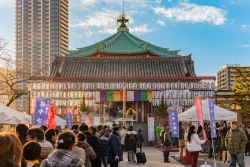
January 22, 2004
A Walk in the Woods
Matt Button heads to Hokkaido and revels in the serenity of Daisetsuzan National Park.
By Metropolis
Originally published on metropolis.co.jp on January 2004

Photos by Matt Button
Ryusuke, our guide, pushes forward through the knee-deep champagne powder snow without even breaking a sweat. Us mortals, however, are huffing, puffing and falling behind. After three days of tearing through the pristine snow of Niseko, we’d grown tired of the crowds and were in need of a little stillness and sanity, and we had come here to find it.
Hokkaido in midwinter is a wonderful place. And a guided tour out in the national parks is even better. So with the help of the Tokachi Adventure Club, a small Hokkaido-based outdoor-adventure company, we went for a walk in the woods.
Land of ice and snow
Populated by deer, fox, bears and a range of rare alpine wildlife and flora, Daisetsuzan National Park is Japan’s largest park, covering 2,309 square kilometers. The massif sits almost squarely in the middle of Hokkaido and to the indigenous Ainu people it was simply called Nutakukamushupe, which translates as “Big Snow Mountain.” In the summer season it has a reputation of being touristy, due to its popular onsen, but in winter the crowds are drawn instead to nearby ski areas such as Furano. Most visitors to “The Roof of Hokkaido” enter either from the north through Asahikawa or Kamikawa, or, as we had, through Obihiro in the south.

Dressed in warm one-piece ski suits and armed with snowshoes and ski poles, our small group ambled along a snow-shrouded service road while we got our snow legs. The panting of flabby city folk was slowly replaced with quiet chatter and hushed respect for this secret winter garden. The crunch of snow, the crystal-clear air, and healthy exercise were a heady mixture, leaving us giddy and smiling from ear to ear.
Dubbed “The Roof of Hokkaido,” Daisetsuzan offers unlimited alpine adventures
Hokkaido’s wildlife bears a greater resemblance to that of Russia than Japan’s main islands. The tracks of northern foxes crisscrossed our path and birds went about their business above in the Yezo spruce and Sagalier fir. Daisetsuzan National Park is home to the rare black woodpecker (Dryocopus Martius) and Blakiston’s fish owl (Ketupa blakistoni) as well as pika, marmots, mouse hares and, of course, brown bears. Brown bears, which can grow up to 2m and weigh 400kg, have a reputation for being a grumpy lot, especially the females, but we trudged in the knowledge that they were all tucked up safely in bed until spring. So on we strolled, happily finding our rhythm and relaxing more and more with every step.
This all changed as Ryusuke stopped and looked up into the forest at some point visible only to him. Seconds later, the serenity of the forest was shattered as we turned off the path and began our climb up through the trees. Snowshoeing up a steep gradient was not anywhere as simple as the guide made it look; he walked on water while the rest of us had to swim. Sliding, slipping, struggling and tripping, we hauled ourselves up the slope towards the unseen destination.
There at the top, among the todomatsu trees, we sat on an old log eating onigiri and chips as the beauty of wild Hokkaido washed in between misty breaths.
A river runs through it
Refreshed, refueled and just as the cold began to creep in, we faced the descent. Charging down the slope, plumes of crystals bellowing behind and faces beaming with exhilaration, some of the more daring attempted to jump over, duck under or fly off logs as if snowboarding or skiing. Most failed to negotiate every last branch and bush, which sent the laughter and heckling into overdrive.

At the bottom, Ryusuke swept up the giggling mess and returned us to the van. On the way back we chattered and relived our epic-or not so epic-descents and heroics. As we drove along with the frozen Tokachi River below us, Ryusuke quickly pulled over to the side of the empty road and motioned for us to be quiet and follow him out of the van. He pointed silently up into the hillside and there, fleeing from our nosy stares, was a group of sleek sika deer. Before anyone could raise a camera, they evaporated silently into the trees.
Once back at base, bellies full and souls restored, we spent the rest of the afternoon wandering peacefully around the nearby countryside along the safely frozen Tokachi River. From swirls of milky blue through turquoise flashes to bottle-green stripes, the ice was both mesmerizing and malevolent-looking. We threaded our way through the trees and down to the ice, strolling over and along the river, under the cliffs, through more trees, and on and on. In this quiet winter landscape it was easy to find a million reasons to stay and just keep walking…
Tours through Japan’s largest national park include back-country snowboarding.

Getting there
The most popular stepping-off point for visitors to Daisetsuzan National Park is Asahikawa, the second largest city in Hokkaido after Sapporo. The flight from Haneda takes approximately 1hr 35min. The JR Limited Express from Sapporo station takes 1hr 28min. The popular Sounkyo Gorge and Furano ski resort are easily accessible from Asahikawa. Obihiro, a popular onsen resort along the Tokachi River in southeastern Hokkaido, is also 1hr 35min from Haneda. Visit www.jnto.go.jp for maps and further travel information.
Where to stay
Grandly (self) titled “the St. Moritz of Asia,” Niseko has winter accommodation for almost every budget. Closer to Daisetsuzan National Park, in Sounkyo, are a number of traditional ryokan with access to area onsen. For information and help with reservations, see http://japaneseguesthouses.com/db/sounkyo/. The Tokachi Adventure Club also has a log cabin-style clubhouse, which is clean and warm. See contact details below.
More information
T.A.C.’s offices sit on the bank of the Tokachi River. The club runs a variety of tours that include canoeing, kayaking, ski/snowboard back-country guided ventures, snowshoeing, ice climbing, cross-country skiing, and a Telemark ski school. They also offer combinations of the above plus a visit to an onsen. If you have anything else in mind this friendly little company can help you arrange it. Tel: 01566-5-2727, fax: 01566-5-2728, email: tac99@d3.dion.ne.jp. Visit www.tac-go-go.com for more information.
[geo_mashup_map]







